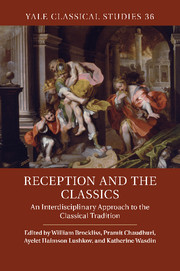Book contents
- Frontmatter
- Contents
- Notes on contributors
- Acknowledgements
- Chapter 1 Introduction
- Part I Reception between Transmission and Philology
- Chapter 2 “Arouse the dead”: Mai, Leopardi, and Cicero's commonwealth in Restoration Italy
- Chapter 3 Honor culture, praise, and Servius’ Aeneid
- Chapter 4 Joyce and modernist Latinity
- Chapter 5 Lyricus vates: musical settings of Horace's Odes
- Part II Reception as Self-Fashioning
- Part III Envoi
- Bibliography
- Index
- References
Chapter 5 - Lyricus vates: musical settings of Horace's Odes
from Part I - Reception between Transmission and Philology
Published online by Cambridge University Press: 05 December 2011
- Frontmatter
- Contents
- Notes on contributors
- Acknowledgements
- Chapter 1 Introduction
- Part I Reception between Transmission and Philology
- Chapter 2 “Arouse the dead”: Mai, Leopardi, and Cicero's commonwealth in Restoration Italy
- Chapter 3 Honor culture, praise, and Servius’ Aeneid
- Chapter 4 Joyce and modernist Latinity
- Chapter 5 Lyricus vates: musical settings of Horace's Odes
- Part II Reception as Self-Fashioning
- Part III Envoi
- Bibliography
- Index
- References
Summary
I first became aware of a connection between Horace's Odes and music as an undergraduate, when I read in Eduard Fraenkel's Horace that “not very long ago [i.e., from the perspective of the 1950s] it was the custom at many German schools to have the first stanza [of Odes 1.22, Integer vitae] sung at the funeral services in Hall, to a tune not distinguishable from that of an ordinary church hymn; the tempo, needless to say, was molto adagio.” Fraenkel was referring to a musical setting of the poem by F. F. Flemming (1778–1813), which gained wide circulation in both English- and German-speaking countries.
Much more recently, in an amateur choral group, I performed a setting by Randall Thompson (1899–1984) of another solemn-sounding passage from the Odes, the final stanza of Odes 1.13, beginning Felices ter (“Three times happy”). While those two pieces represent a tiny and purely random sample of a large body of Horatian musical settings, they nevertheless share what we shall find to be several recurring features of the Odes’ reception in music: they select a portion of an ode rather than setting the entire poem, they transform Horace's individual voice into a choral utterance, and they turn texts that are playful or ironic in their original context into morally uplifting statements. In other words, they are in significant respects unfaithful to their Horatian originals. Those alterations in turn suggest that the Odes, although they have proven attractive to composers, are at the same time in some ways resistant to musical treatment.
- Type
- Chapter
- Information
- Reception and the ClassicsAn Interdisciplinary Approach to the Classical Tradition, pp. 72 - 94Publisher: Cambridge University PressPrint publication year: 2011



